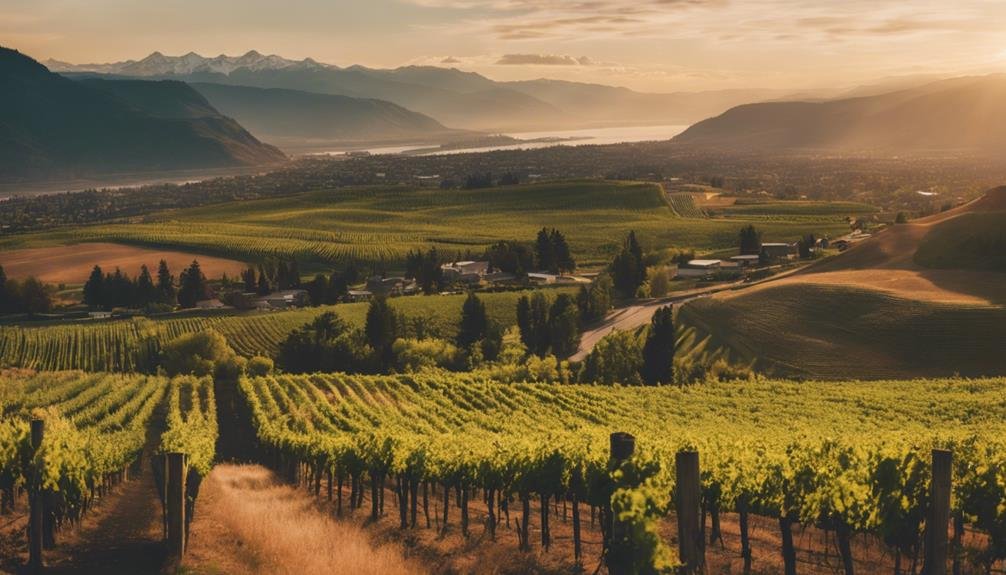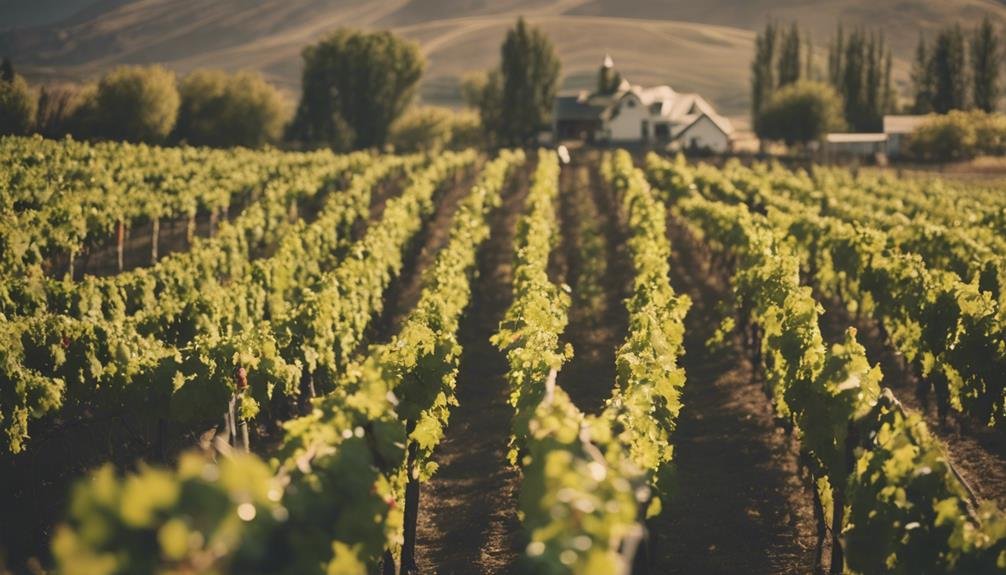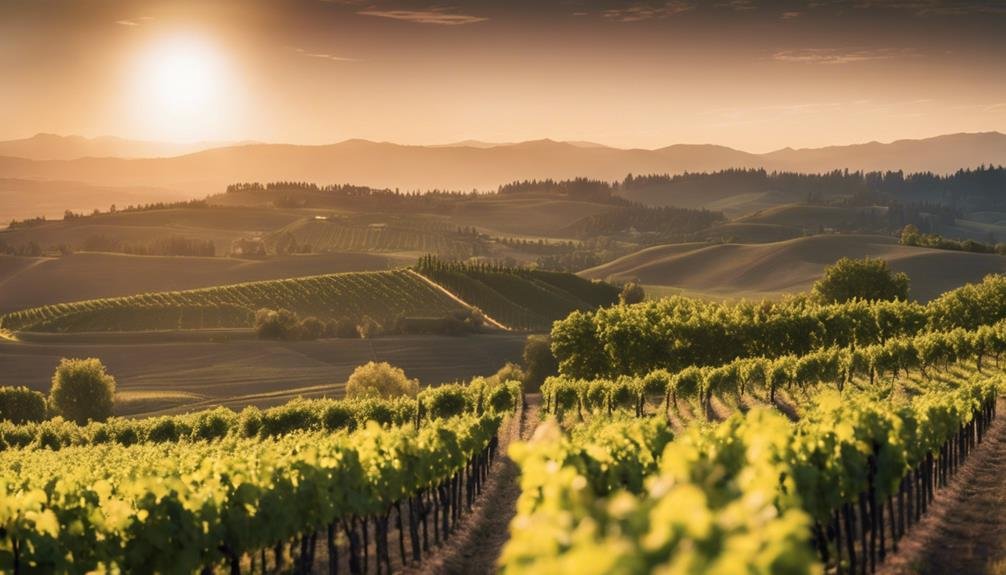Explore Washington's vast Columbia Valley, where winemakers craft high-quality wines in this AVA established in 1984. With a varied terroir and climate, it's renowned for Riesling and bold Syrah wines. Notable regions like Yakima Valley and Red Mountain produce exceptional Cabernet Sauvignon and Chardonnay, with unique terroir and bold flavors. Discover distinctive AVA characteristics like ancient riverbed cobblestones in Rocks of Milton-Freewater imparting unique flavors. From organic farming to climate challenges, the innovative practices of winemakers shine through. Uncover the secrets of this wine haven where quality and innovation meet, creating a true oenophile's paradise.
Columbia Valley AVA Overview
Established in 1984, the Columbia Valley AVA in eastern Washington State and a small part of Oregon is a sprawling expanse of vineyards covering 50,316 acres, making it the heart of Washington wine country.
Climate challenges in this region include an average annual rainfall of 6 to 8 inches, similar to the Gobi Desert.
The soil composition varies across the AVA, with sedimentary soils, sandy loam, and gravelly soils being prevalent. These soil types contribute to the diverse terroir of the region, offering unique characteristics to the wines produced.
Winemakers in the Columbia Valley navigate these climate challenges and soil variations to craft a wide range of high-quality wines that showcase the distinct flavors and profiles of the area.
Columbia Valley Wine Varieties
The diverse terroir and climate of the Columbia Valley AVA give rise to a fascinating array of wine varieties that showcase the region's unique winemaking potential. Columbia Valley is renowned for its Riesling revolution, producing aromatic and vibrant Riesling wines that captivate enthusiasts worldwide.
Additionally, the region's exploration of Syrah has led to the creation of bold and expressive Syrah wines that highlight the terroir's complexity. With a focus on quality and innovation, Columbia Valley winemakers continue to push boundaries, crafting exceptional white wines like Riesling, Viognier, and Sauvignon Blanc, as well as robust red wines such as Cabernet Sauvignon, Merlot, and Syrah.
This dedication to diversity and excellence solidifies Columbia Valley's position as a prominent player in the world of winemaking.
Notable Columbia Valley Wine Regions

Yakima Valley stands out as the oldest AVA within the Columbia Valley wine region, boasting a diverse climate that is renowned for producing exceptional Cabernet Sauvignon and Chardonnay wines.
Red Mountain, a small but significant region within Columbia Valley, is known for its unique terroir that produces tannic red wines like Cabernet Sauvignon and Syrah. This area's warm days and cool nights contribute to the bold flavors found in the wines.
Yakima Valley's diversity allows for the cultivation of a wide range of grape varieties, making it a prime location for wine production. Together, these regions showcase the richness and variety that the Columbia Valley has to offer to wine enthusiasts seeking high-quality and diverse wine experiences.
Unique AVA Characteristics
With distinct terroirs and climatic influences, various AVAs within the Columbia Valley showcase unique characteristics that contribute to the diversity and quality of wines produced in the region. The Rocks of Milton-Freewater AVA stands out for its Rhône varieties, featuring ancient riverbed cobblestones that impart distinctive flavors to the wines.
Horse Heaven Hills AVA, known for its expansive region, is home to Washington's first 100-point wines, showcasing the innovative practices employed by winemakers in the area. These AVAs, along with others like Snipes Mountain and Rattlesnake Hills, highlight the diverse and dynamic nature of the Columbia Valley wine region.
From the ancient riverbeds to the innovative practices, each AVA adds a unique touch to the exceptional wines produced in this wine haven.
Vineyard Practices and Climate Impacts

Vineyard practices and climate impacts greatly influence the cultivation and quality of wines in Washington's Columbia Valley AVA. Organic farming is gaining traction, albeit limited, in the region, promoting sustainability and reduced chemical usage. However, the arid climate poses significant challenges, with average annual rainfall akin to the Gobi Desert, necessitating irrigation for vine growth.
Diverse climate conditions within the AVA demand meticulous wind management to prevent diseases and optimize grape development. While some vineyards embrace organic and biodynamic approaches, the majority rely on conventional methods due to the demanding climate.
Wineries in the Columbia Valley navigate these climate challenges to produce distinctive wines, showcasing the interplay between vineyard practices and the environment's impact on wine production.
Frequently Asked Questions
What Is the Significance of the Columbia River in the Columbia Valley Wine Region?
The Columbia River plays a crucial role in the Columbia Valley wine region, providing essential water supply for vineyards. Its waters, sourced from the Cascade Mountains snowmelt, support sustainable wine production by irrigating the diverse vineyards of this renowned wine-growing area.
How Do the Unique Soil Types in Columbia Valley Influence Wine Flavors?
Soil composition in Columbia Valley, with its diverse range of types such as sandy loam, silt, and gravel, profoundly influences wine flavors, contributing unique characteristics. Combined with vineyard microclimates and precise irrigation techniques, this creates distinct and complex flavor profiles in the wines.
What Are the Challenges of Grape Growing in the Columbia Valleys Desert-Like Climate?
Grape growing in the Columbia Valley's desert-like climate poses challenges in water management due to low rainfall and high sun exposure. This necessitates irrigation from the Columbia River and snowmelt, impacting vineyard practices and grape development.
How Does the Columbia Valley Compare to Other Wine Regions in Washington State?
The Columbia Valley stands out among Washington wine regions due to its diverse climate conditions influencing harvest timing. Known for producing bold reds like Cabernet Sauvignon and Syrah, it showcases unique potential for grape varietals and wine production.
Are There Any Sustainable or Organic Vineyard Practices Being Implemented in the Region?
Organic practices and sustainable vineyards are gaining traction in the Columbia Valley region, emphasizing environmental stewardship. While limited in number, some vineyards are adopting these practices to minimize chemical inputs and promote long-term ecosystem health.
Conclusion
To sum up,
the Columbia Valley AVA in Washington State stands as a vast wine haven, producing a diverse range of high-quality wines from bold reds to exquisite whites and rosés.
With unique terroir characteristics shaped by its arid climate and reliance on water sources,
this region continues to captivate wine enthusiasts with its exceptional quality and distinct flavors.
From Cabernet Sauvignon to Syrah,
the Columbia Valley remains a premier destination for wine lovers seeking a truly memorable tasting experience.
